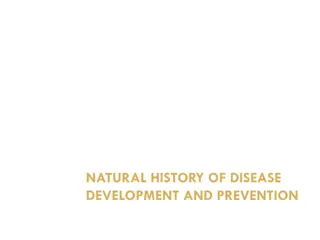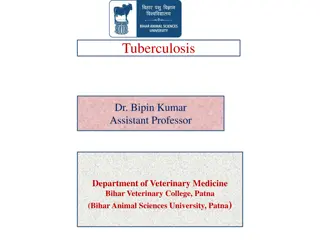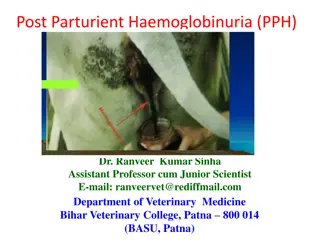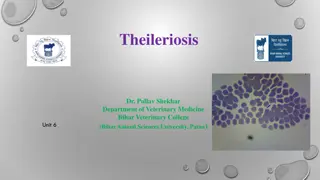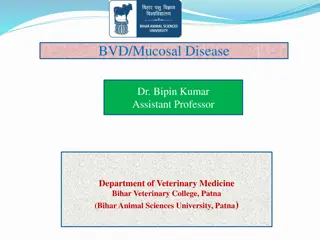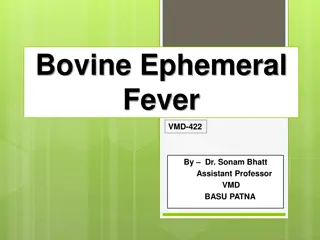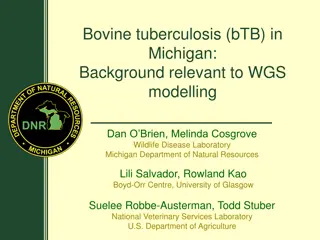Study on Long-Term Prevention of Bovine Hardware Disease in Buffaloes
Buffaloes play a significant role in livestock agriculture, but foreign body syndrome poses a threat globally. This study aims to evaluate the efficacy of using rumen magnets as a long-term preventive measure against hardware disease in buffaloes. The incidence of the disease is high in developing countries, leading to economic losses, reduced productivity, and potential fatalities. The study explores the need for a more sustainable preventive strategy to safeguard buffaloes' health and well-being.
Download Presentation

Please find below an Image/Link to download the presentation.
The content on the website is provided AS IS for your information and personal use only. It may not be sold, licensed, or shared on other websites without obtaining consent from the author. Download presentation by click this link. If you encounter any issues during the download, it is possible that the publisher has removed the file from their server.
E N D
Presentation Transcript
By Ashraf M. Abu-Seida Professor of Surgery, Anesthesiology & Radiology Professor of Surgery, Anesthesiology & Radiology Faculty of Veterinary Medicine Faculty of Veterinary Medicine - - Cairo University Cairo University
Introduction Buffaloes are an important part of livestock agriculture in Asia since 5000 years, producing milk, meat, hides and draft power. Foreign body syndrome of bovine is still a matter of concern in different veterinary practices all over the world. Hardware disease is an alternative term for bovine traumatic reticuloperitonitis and sharp foreign body syndrome.
Introduction Ingestion of a sharp object Settlement in the reticulum Irritation or penetration of the reticular wall Several complications.
Introduction Traumatic Reticulitis Traumatic Reticuloperitonitis (local and diffuse) ReticularAbscess Traumatic Pericarditis Diaphragmatic Hernia Vagal Indigestion HepaticAbscess SplenicAbscess Pleurisy and MediastinalAbscess Traumatic Pneumonia Ruptureof leftgastro-epiploic artery Hernia hepatic abscess
Introduction The incidence of the disease is high in all developing countries as Egypt Iraq India losses in affected pregnantanimals Economic losses Sharp drop in milk yield Reduction in meat production Economic losses Potential fatalities Treatment costs Fetal Losses
Introduction Reticular magnets has become a popular preventive routine forthe hardware disease but there is no report concerning its efficacy as a long term preventive measure
Aim of the study Is it enough to use rumen magnet once a life to permanently prevent disease in buffaloes? hardware
Materials and Methods Animals Time of the study: 8 years 3100 buffaloes Iraq
Materials and Methods 1200 buffaloes suffered from hardware disease. Group I Rumenotomy was carried out for these buffaloes and rumen magnet was dropped into the reticulum. Group I Follow up for seven years was done. Repeated rumenotomy was carried out in all buffaloes that had recurrent hardware disease Group I
Materials and Methods 1900 healthy buffalo heifers given prophylactic ruminal magnets orally at the age of 6-9 months Group II These animals were followed up for seven years for any complications and possible occurrence of hardware disease Group II Rumenotomy was carried out in hardware diseased buffaloes Group II
Materials and Methods Statistical analysis: Proportions of buffaloes which developed hardware disease during the first 4 years and at 5 , 6 and 7 year after the use of magnet were compared using chi-square test in IBM SPSS (version 20) within and between group I and group II and all data were reported.
Results In group I: The affected animals were 1195 females and 5 buffalo bulls of 2-9 years old. No complications were reported after dropping of magnets into the reticulum Recurrent hardware disease was recorded in 110 animals representing10.8% of the total examined buffaloes.
Results In group II: Regurgitation was recorded in 1.5% of the total examined heifers. Hardware disease was diagnosed in 155 animals representing 8.9% of the total examined animals.
Results The incidence of developing a hardware disease during the first 4 years after the use of rumen magnet was 0% in both groups. Starting from 5th. year, a time dependent increase in the proportion of buffaloes developing a hardware disease was noticed in both groups
Results Numbers of animals Group I Group II Total examined buffaloes Discarded buffaloes 1200 185 1900 154 Followed up buffaloes Hardware diseased buffaloes during 1st. 4th. year post magnet use Hardware diseased buffaloes during 5th. year post magnet use Hardware diseased buffaloes during 6th. year post magnet use Hardware diseased buffaloes during 7th. year post magnet use Total hardware diseased buffaloes Different alphabets indicate significant difference within the same group at P< 0.01 *Asterisks denote a statistical difference between groups at P < 0.05 1015 0a 1746 0a 23 (2.3%) b 35 (2.0%) b 39 (3.8%) b 43 (2.5%) b* 48 (4.7%) c 77 (4.4%) c* 110 (10.8%) 155 (8.9%)
Results Complete filling of cage magnets with foreign bodies. The magnetic power of the retrieved reticular magnets was similar to the new one
Results The trapped metallic foreign objects included wires, nails, needles, knives, keys, coins, screws, rings, can-openers and iron pieces of various sizes. In addition, other non-metallic foreign bodies as bones, feathers, gravels, stones, sand, pieces of rubber, glass and clothes, shoes, ropes and plastic bags were also removed during rumenotomy.
Results Traumatic Reticulitis (n=608) LocalTraumatic Reticuloperitonitis (n=461) Reticular Abscess (n=191) Diffuse Traumatic Reticuloperitonitis (n=96) Traumatic Pericarditis (n=68) Diaphragmatic Hernia (n=32) Splenic Abscess (n=9)
Conclusions Administration of the rumen magnets is an effective prophylaxis for hardware disease in buffaloes. It is not enough to use rumen magnet once a life to permanently prevent this disease in buffaloes at high risk. Reapplication recommended four years later. of a new magnet is








